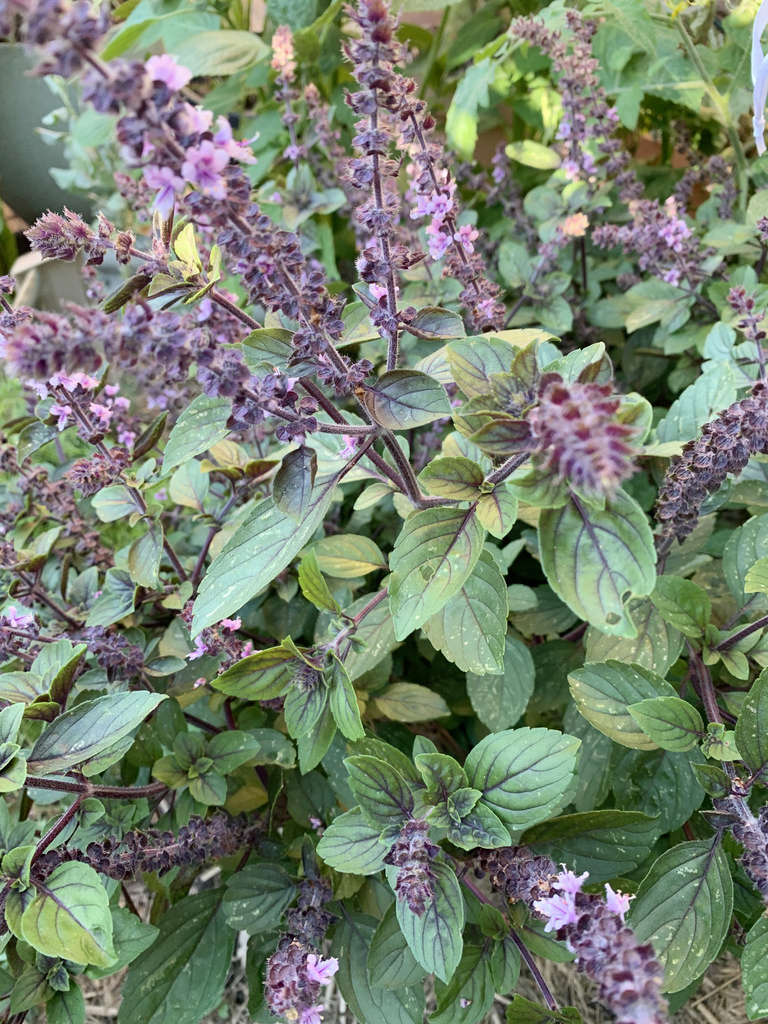One of the most beautiful perennial and edible herbs to have in the garden is the African Blue Basil. Here’s how to grow it, eat it and drink it.

African Blue Basil – Photo © The Gourmantic Garden
As seen on Botanical Beverages: My Segment on Gardening Australia
AFRICAN BLUE BASIL
African blue basil is a hybrid, a cross between Ocimum kilimandscharicum (camphor basil) and Ocimum basilicum (dark opal). What this means for this variety is that the plant can’t be grown from seed and can only be propagated by cuttings. While it may seem to place it at a disadvantage, its hybrid status means you can leave the flowers on the plant without the worry of the plant dying.
The leaves of the plant have a beautiful purple hue which turns a deep green shade when the plant matures. The purple flowers are simply stunners. They’re long and elegant and are a magnet for bees and other pollinators. Since I planted African blue basil in my garden, native blue banded bees appeared, something I had not seen before.
GROW IT

African Blue Basil – Photo © The Gourmantic Garden
As mentioned earlier, it can’t be grown from seed. I bought mine online as a small seedling and it has proved to be a worthy investment. Like all basil, it likes sunshine and good draining soil. It grows to about 80cm tall and spreads as wide so allow ample space. If planting it in a container, use the largest possible as the plant likes to spread and goes bushy.
Every now and then, give the herb a prune to tidy up the shape but don’t throw away the cuttings. The leaves are edible, of course, and if you use it as a cut flower, change the water every couple of days and it will form roots which you can propagate and have more plants.
EAT IT

Purple Flowers – Photo © The Gourmantic Garden
African blue basil can be used like sweet basil with the advantage of having it all year round. It has an earthy basil taste with less of an aniseed note than other perennial types of basil. Use it in salads, make pesto, use it on pizza and pasta, in bruschetta, as garnish and so on. It is so versatile and the beautiful colour of the leaves brightens up any dish.
DRINK IT
You can add it to a green smoothie if you wish but we have another use for the plant. Aside from using it as a cocktail garnish, we use it as an ingredient in frozen cocktail and slushies. Stay tuned, we will be sharing the recipe in January 2021 on our sister website, Cocktails & Bars.
AFRICAN BLUE BASIL GROWING GUIDE AT A GLANCE

Deep Green Leaves – Photo © The Gourmantic Garden
For temperate climate (Sydney, Australia)
- Sowing Season: n/a
- Sowing Method: propagation
- Position: full sun
- Seed Preparation:n/a
- Soil: well draining soil
- Sowing Depth: n/a
- Plant Spacing: 80cm
- Row Spacing: n/a
- Plant Height: 80cm
- Germination: n/a
- Time to Maturity/Harvest: n/a
- Water Requirements: keep moist
- Fertiliser Requirements: occasional liquid fertiliser
- Companion Planting: tomatoes
- Ones to Avoid: n/a
- Succession Planting: n/a
Want to Know More?
You’ll find more information on how to grow basil, which varieties to try, how to pair it with food and spirits, and how to use basil in cocktails including a full recipe in my 260+ page digital book GROW YOUR OWN COCKTAIL GARDEN available now.


